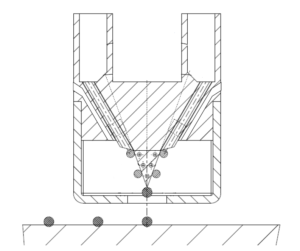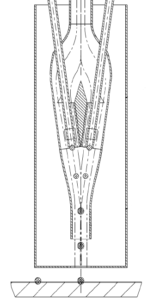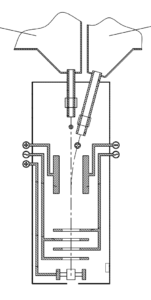Additive manufacturing (3D printing) has a potential to revolutionize almost every aspect of human endeavor. Currently there are a handful of techniques that allow us to form objects via addition of material. Most commonly used techniques utilize material prepared before printing. Which is deposited and either melted, sintered or hardened to form desired product. Among the most important of the 3D printing techniques are Fused Deposition Modeling (FDM), Selective Laser Sintering or Melting (SLS, SLM) and Stereolithography (SLA). Reactive Inkjet Printing (RIP) is a method in which a material is formed by chemical reaction during the process of deposition. In this way the material is being created during the deposition which allows for more flexibility. There is no need to use three different filaments, just two that can be mixed in different proportions. The scope of possible materials is much greater than in well-established techniques. Using this mode allows the change of created material during the printing process. Thus allowing to manufacture products with gradual change in various properties such as color, elasticity, conductivity.
- Fig. 1 Printing head with a separator
- Fig. 2 Printing head with compressed air as separator
- Fig. 3 Printing head with guiding electric fields
The RIP approach is somewhat similar to SLA. Unlike the SLA where the liquid ink is solidified by the UV light, in RIP the liquid is solidified by the chemical reaction between different ingredients. For this reason RIP does not come with the limitations associated with appliance of the UV light.
Since the components of the ink are reactive the ink parts must be kept separate. This approach requires specially designed chemical components that will react rapidly to quickly gel the deposited material to allow for building of the product layer by layer. The gel has to be chemically reactive to bond to the next as well as previous layer. Mixing different components in different proportions allows for obtaining materials with changing parameters i.e. lowering the amount of the hardening agent during the printing process will result with materials having higher elasticity. As we change the proportions during the printing process we can manufacture products with a gradual change of properties.
This approach can be utilized in 3D printing as well as in 2D printing. In 2D printing ink consists mostly of solvent that needs to either evaporate or sink into the material. Since the deposited material can be colored and does not contain any solvent, RIP can become a chance for solvent-less inkjet printing.
The true challenge lies in combining the two components in a way that ensures solidification will not occur prematurely. We developed a few strategies in order to solve this problem. First the mixing of the components cannot occur with the contact to the solid material of the dispenser. This would result in clogging since the components solidify rapidly. In order to resolve this problem we need to mix the components on the surface or when the components are approaching the surface. To successfully mix the components on the surface the knowledge of precise distance to the surface is required. Since the droplets of the deposited material are small relative to the distance traveled even small deviations in the distance to the surface would result in components not hitting each other. Which would result with components not mixing, and the reaction wouldn’t occur. To make this approach widely usable we need to allow for greater tolerance. This is why there is a need to develop a type of dispenser that would allow us to mix the components within the printing head but before the surface. To facilitate such a process requires a specially designed printing head.
- Fig. 5 Mixing of the components in a 1 to 1 ratio
- Fig. 5 Obtained material from 1 to 1 ratio
The printing head has to perform two tasks. First it has to allow for the mixing of the components, secondly it must minimize the possibility of clogging. We have prepared several designs. The dispensers of the reactive components must be separated to minimize the chance that the dispensing nozzle would clog. This is achieved by either adding a physical barrier (Fig 1), stream of compressed air (Fig 2) or electric field, if the components are charged. Additionally the whole printing head can be washed with compressed air to remove any satellite component droplets that can be created during deposition. Washing will further reduce the chance of clogging but can impede the precision of the printing, due to turbulences of air near the surface. Secondly, the printing head must be able to mix the components without the contact with the mixed components. The simplest solution, the dispensers are inclined to each other to allow the reactive components to collide with each other and mix the ingredients before they hit the surface. This is illustrated on the figure 2. The printing head may have a special system that will guide the component to the mixing point with the other component without the contact with the material of the printing head. This can be achieved by guiding the components by the flow of air, or by means of utilizing electric fields (Fig 3).
- Fig. 6 Mixing of the components in a 1 to 6 ratio
- Fig. 6 Obtained material from 1 to 6 ratio
This technology is still at early stages of development, but we are confident that the end result will allow for easy manufacturing of products with a gradual change of properties in manufactured materials or for solvent-free printing on ordinary surfaces. In our laboratory we are developing new sets of components that will allow for the gradual change in composition, as well as designing better printing heads to tackle any arising obstacles. Our results are promising and the concept was tested in the laboratory scale. In the pictures you can observe our laboratory setup for studying the process of combining of the two reactive inks (fig 4), and the results of our experiments when combining of the components at 1 to 1 ratio (fig 5) and at 1 to 6 ratio (fig 6). This technology still needs a lot of work in order to make it commercially available. But maybe it is high time to associate RIP not with “The End” but with the many new possibilities that this technology can deliver.
Maciej Zawadzki of the Warsaw University of Technology and Piotr Jeute of Promark Service introduce Reactive Inkjet Printing.
Jeute explains of future plans for the technology:
Generally speaking the project is to be commercialized at least partially, but this does not seem to happen within at least next 2 years. We have plans to develop the whole range of printers for different applications, but it will take lots of time and resources to reach the point where the proof of concept would apply not only to general principles of the technology, but also to specific prototypes for specific applications. As of today we know that it does work and is doable based on the working model which shows the real coalescence, diffusion and chemical reaction of solidification in operation. From this point there is still a very long way to the point, where we could say the technology is applicable to industry and precisely evaluate, what it would take to apply it commercially.
At this stage we are not prepared to sell anything and are doing well on our own. Having said that I still admit, that we remain open for any kind of partnership with persons or firms who could contribute to the project with their specific knowledge or know how rather than capital in order to enhance the R&D process.
Subscribe to Our Email Newsletter
Stay up-to-date on all the latest news from the 3D printing industry and receive information and offers from third party vendors.
You May Also Like
3D Printing Unpeeled: New Arkema Material for HP, Saddle and Macro MEMS
A new Arkema material for MJF is said to reduce costs per part by up to 25% and have an 85% reusability ratio. HP 3D HR PA 12 S has been...
3D Printing News Briefs, January 20, 2024: FDM, LPBF, Underwater 3D Printer, Racing, & More
We’re starting off with a process certification in today’s 3D Printing News Briefs, and then moving on to research about solute trapping, laser powder bed fusion, and then moving on...
3D Printing Webinar and Event Roundup: December 3, 2023
We’ve got plenty of events and webinars coming up for you this week! Quickparts is having a Manufacturing Roadshow, America Makes is holding a Member Town Hall, Stratafest makes two...
Formnext 2023 Day Three: Slam Dunk
I’m high—high on trade show. I’ve met numerous new faces and reconnected with old friends, creating an absolutely wonderful atmosphere. The excitement is palpable over several emerging developments. The high...







































